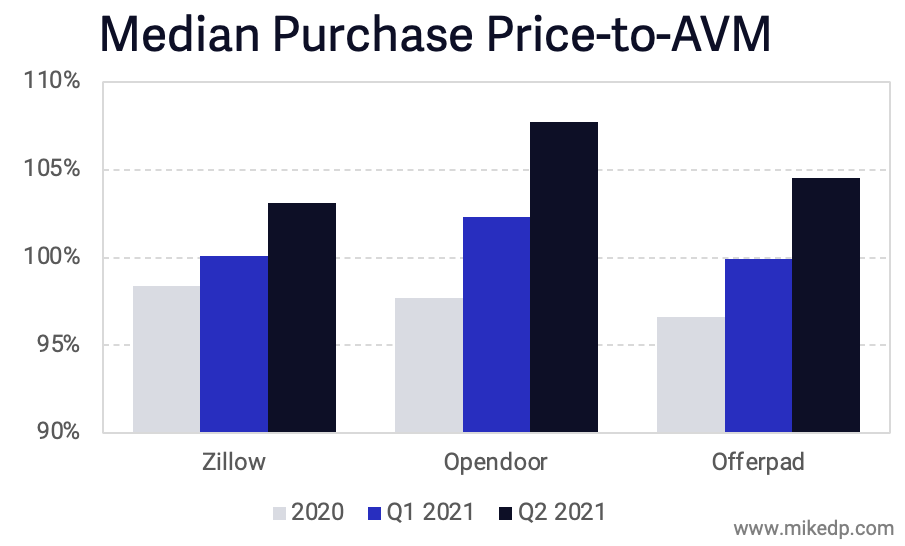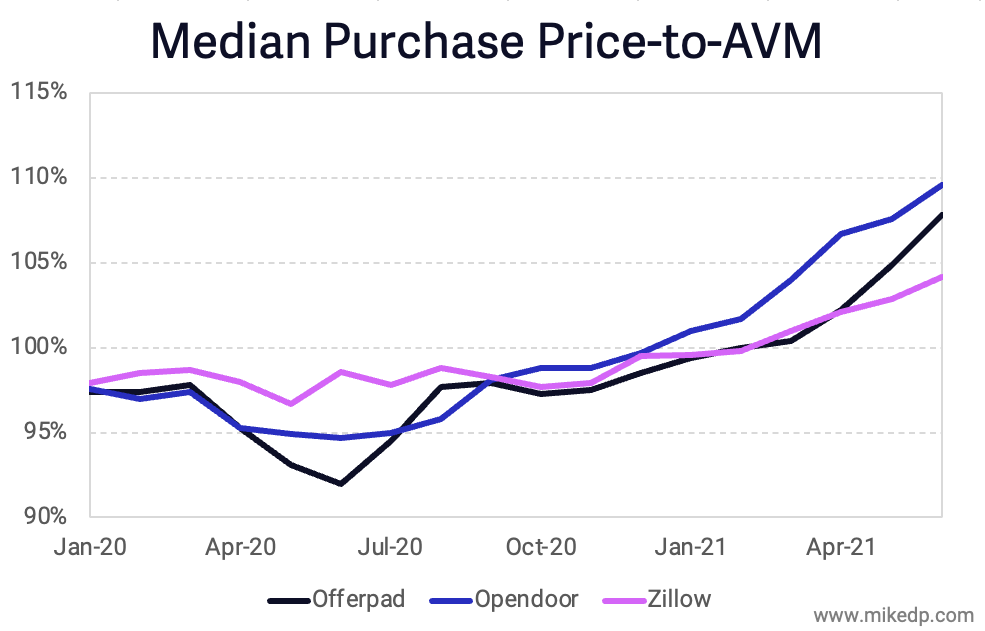iBuyers: Paying Above Market and Reselling For More Upside
/With unprecedented demand and constrained supply, house prices are rising across the U.S. Consequently, the iBuyers -- led by Opendoor, Zillow, and Offerpad -- are paying record-high, above market values for the homes they’re purchasing from homeowners. But they're also reselling them for more money than ever before.
Purchase Price-to-AVM
Purchase Price-to-AVM is a comparison of the price an iBuyer pays for a house compared to what an AVM (automated valuation model) determines the house is worth at the time of purchase. This study uses the ATTOM Data AVM.
Historically, iBuyers paid a point or two below “market value.” My previous research study, conducted in 2019, found a median Purchase Price-to-AVM of 98.6 percent for Opendoor and Zillow. But things have radically changed in 2021; the number is well over 100 percent, with Opendoor paying a median of 107.7 percent in Q2 2021.
To be fair, most of the market is paying above "market value" in the housing frenzy of 2021. And for iBuyers, this trend has accelerated over the past six months, led by Opendoor. As a newly-listed public company, Opendoor needs to demonstrate strong revenue growth, and the only way to do that is by buying and selling more houses.
This shift -- and Opendoor’s strategy -- is clearly visible when analyzing its Purchase Price-to-AVM distribution compared to Zillow. In 2020, both companies were nearly identical, with a median Purchase Price-to-AVM of around 98 percent.
But in the first half of 2021, Opendoor materially shifted to the right, paying, on average, significantly higher prices for houses.
Over the past 18 months, Opendoor has clearly shifted to paying more for homes, with a much looser price distribution than the past.
The above chart can be interpreted a number of ways: houses are getting more expensive (they are), Opendoor is paying more for houses (it is), and pricing is becoming harder to predict with an AVM. But there also appears to be a shift from the tight pricing discipline of 2020 to a free-for-all, acquire at any cost strategy.
The trends adhere to the fundamental principles of supply and demand: with housing in short supply, iBuyers need to increase the quality of their offers. But this doesn't negatively affect their margins; in fact, iBuyers are reselling homes for more money than ever before.
Rising Price Appreciation
Once an iBuyer purchases a house, they quickly spruce it up and resell it -- ideally for more than they bought it for. This difference, the spread between the purchase and resale price, is price appreciation.
In 2021, the median price appreciation for iBuyer transactions is 8.1 percent -- a record high -- up from 4.7 percent in 2020 and 3.3 percent for Opendoor and Zillow in 2019. And it continues to climb, with Opendoor hitting 9.2 percent in May 2021.
Combined with 2021's 40 percent increase in the median value of homes purchased by iBuyers, price appreciation approaching 10 percent is financially significant.
Consider: median price appreciation of 3.3 percent on a $250k home in 2019 is $8,250, compared to 9.2 percent (Opendoor's price appreciation in May 2021) on a $350k home, which is $32,000.
And the results vary by market. An analysis of 262 iBuyer transactions in Phoenix during May and June shows a median price appreciation of 11.5 percent, or $39,000, after a median of just nine days on the market (total hold time is about two months).
It's no wonder that iBuyers are happy to pay more for houses and abandon their tight price discipline; they're more than making up for it on the resale.
A Note on Data Sources
The data above is primarily sourced from national public property records, with some data from the Phoenix MLS. Price appreciation is calculated by taking the percentage difference between sale price to purchase price for matched properties, and then taking the median value of those transactions. It is based on over 20,000 transactions between January 2020 and May 2021. Thanks to my good friend Suhel Mangera for his assistance crunching the data.
For more, zavvie's recent Seller Preferences Report does a good job of tracking iBuyer offer quality, fees, concessions, and other data that's relevant for consumers.


















